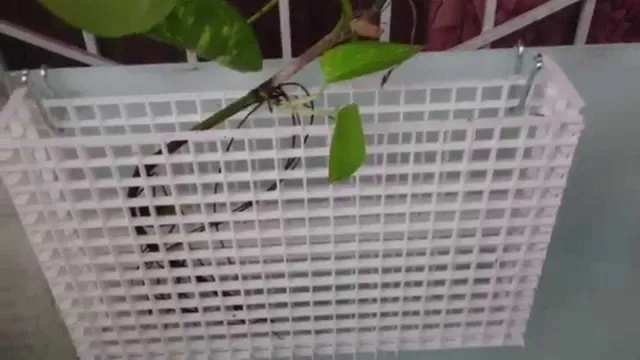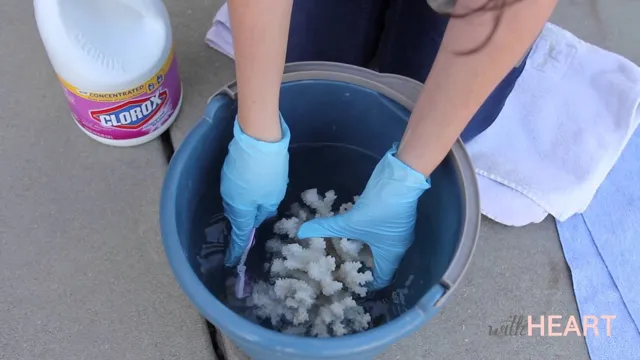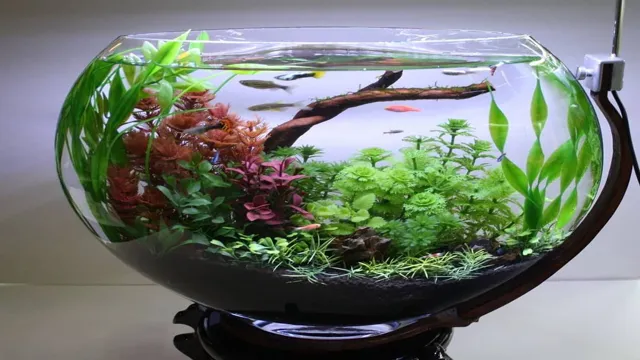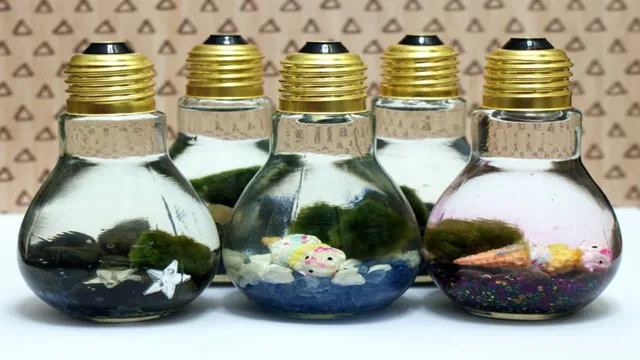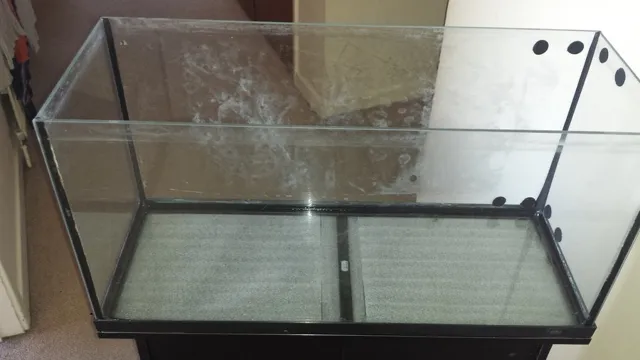How to Get Rid of Surface Scum in Aquarium: Tips and Tricks to Keep Your Tank Clean
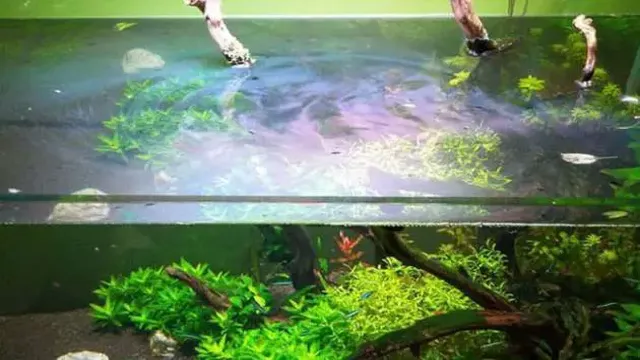
Are you tired of seeing that greasy film on the surface of your aquarium? It’s not only unsightly but can also impact the health of your fish, plants, and other aquatic organisms. Surface scum is caused by a combination of factors such as waste buildup, uneaten food, and oils from aquatic plant leaves. But don’t worry, getting rid of it is easier than you might think.
With a few simple steps, you can restore the cleanliness and clarity of your aquarium water. In this blog post, we will explore some effective methods for eliminating surface scum in your aquarium and maintaining a healthy aquatic environment for your aquatic friends. So, let’s dive in!
Understanding the Causes of Surface Scum
As an aquarist, there’s nothing quite as unsightly as surface scum on the water feature of your aquarium. But what is it, and why does it appear? Surface scum is usually a film that forms on the surface of the water. It’s often caused by a buildup of organic waste, such as uneaten food, dead fish, and plant matter, and eventually turns into a bacterial film.
Additionally, changes in temperature, humidity, and lighting can also contribute to the buildup of surface scum. However, getting rid of surface scum is relatively easy and straightforward. Regularly feeding your fish the right amount of food, making sure to remove any excess before it sinks, and regularly cleaning your filter, gravel, and other debris-catching media are some of the best preventative measures you can take.
Additionally, investing in some surface skimmers and filters can help eliminate the problem altogether. Overall, the key to getting rid of surface scum is to keep your aquarium clean and remove any potential sources of waste in a timely fashion.
Waste Build-up and Poor Water Circulation
One of the main causes of surface scum in aquatic environments is the build-up of waste and poor water circulation. This can occur naturally or be exacerbated by human activity such as agricultural runoff, improperly disposed of waste, or chemical contaminants. When waste, such as decaying organic matter, collects on the surface of the water, it can become trapped in an oily film known as scum.
Poor water circulation allows this scum to accumulate in stagnant areas of the water where it can continue to grow and spread. This can be harmful to aquatic life as it depletes the oxygen levels in the water and disrupts natural ecosystem balances. To prevent surface scum, it is important to properly manage waste and ensure adequate water circulation through the use of pumps, aerators, and other mechanical means.
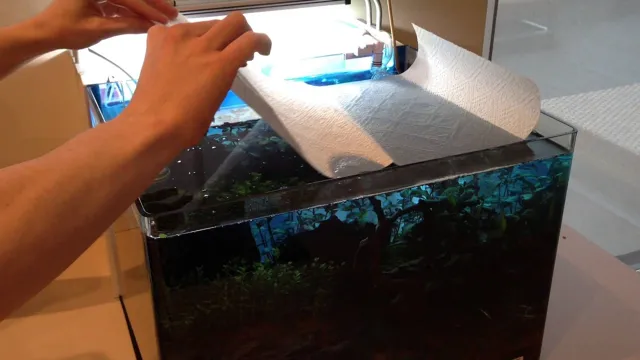
Fish Food and Overfeeding
Fish food and overfeeding can lead to the development of surface scum in your aquarium. This scum appears as a layer of film on the water’s surface and is caused by excess organic matter building up. When you overfeed your fish, the uneaten food breaks down, producing waste that accumulates at the surface.
This waste is often high in protein and other nutrients, providing an ideal environment for bacteria and other microorganisms to grow. As a result, the surface scum forms, which can have detrimental effects on your aquarium’s health. If not addressed, the scum can deplete oxygen levels and increase levels of harmful substances like ammonia, which can be fatal to your fish.
To avoid this, make sure to feed your fish only what they can finish in a few minutes and clean any excess food from the aquarium regularly. This will keep your fish happy and healthy while also preventing the development of a surface scum.
Algae Growth and Poor Lighting
Algae growth is a common problem for aquarium owners, and one of its causes is poor lighting. When there isn’t enough light in the aquarium, the plants cannot perform photosynthesis, which leads to a lack of oxygen and an increase in carbon dioxide. This imbalanced environment results in the growth of algae, which appear as a green or brown surface scum.
But how can we prevent this from happening? The first step is to ensure that your aquarium receives enough natural or artificial light to facilitate photosynthesis. You can achieve this by placing your aquarium near a window, using fluorescent or LED lights, or installing a light timer to simulate daylight hours. Additionally, it’s essential to keep your aquarium clean by regularly removing debris and performing water changes.
By understanding the causes of surface scum, you can better prevent and manage algae growth in your aquarium. Don’t forget to provide your plants with the necessary light to thrive, and keep your tank clean to ensure a healthy and beautiful aquatic environment for your aquatic pets.
Preventative Measures for Surface Scum
Keeping your aquarium clean and healthy can be a real challenge, especially when it comes to dealing with surface scum. This unsightly build-up of organic waste can not only make your tank look unpleasant but can also harm your fish and other inhabitants. Fortunately, there are a few preventative measures you can take to help keep this scum at bay.
First off, make sure to avoid overfeeding your fish, as leftover food is a major contributor to surface scum. It’s also crucial to clean your filter regularly and invest in good quality filter media. Lastly, consider increasing surface agitation by adding an air stone or powerhead to your tank.
This will help to oxygenate the water and keep it moving, preventing scum from accumulating. By following these simple steps, you can wave goodbye to surface scum and enjoy a crystal clear and healthy aquarium!
Reduce Fish Feeding
Reducing fish feeding is a simple yet effective way to prevent surface scum in your pond. Overfeeding your fish can lead to excess nutrients in the water, which can cause an overgrowth of algae and other organisms that create surface scum. To prevent this, it is important to only feed your fish what they can eat in 5-10 minutes, and remove any excess food from the pond.
Additionally, you can try feeding your fish sinking pellets instead of floating pellets, as this can help reduce the amount of food that reaches the surface. By taking these preventative measures, you can keep your pond free from unsightly scum and maintain a healthy environment for your fish. So next time you feed your fish, remember to keep it light and limited to what they need for a healthy diet.
Control Water Pollution
Water pollution is a critical issue that requires our utmost attention. One of the most common concerns is surface scum. This scum consists of unwanted materials such as oil, chemicals, and other pollutants that float on the water’s surface.
It not only spoils the beauty of the water but also harms the aquatic ecosystem. Therefore, it is vital to take preventive measures to control this pollution. One effective solution is to use skimmers.
These help to remove the surface scum by skimming it off the water’s surface. Skimmers are simple and cost-effective devices that can be easily installed in any water body. They work by collecting the scum in a basket or hopper, leaving the clean water behind.
Another useful technique is to plant trees and vegetation around the water bodies. The roots of these plants hold soil particles together, preventing them from washing away or getting into the water. Trees and plants also absorb excess nutrients and pollutants, which in turn, reduce the surface scum.
Overall, taking preventive measures such as using skimmers and planting vegetation around the water bodies is crucial to control the surface scum and prevent water pollution. Let’s take a small step today towards a cleaner environment by adopting these techniques.
Modify Lighting
If you’re dealing with surface scum in your aquarium, modifying the lighting can be a preventative measure to consider. Sunlight and other forms of light can fuel the growth of algae and bacteria, leading to an overgrowth of surface scum. By reducing the amount of light your aquarium is exposed to, you can help prevent excessive algae growth.
One way to modify lighting is by using a timer to control how long your aquarium’s lights are on. This can help ensure that your aquarium gets the right amount of light without overexposure. Additionally, consider the type of lighting you use in your aquarium.
LED lights provide a more natural lighting environment and can help keep algae growth under control. So, if you’re dealing with surface scum, modifying your aquarium’s lighting can be an effective way to address the problem.
How to Remove Surface Scum
Are you struggling to get rid of surface scum in your aquarium? Don’t worry, you’re not alone. Surface scum is a common occurrence and can be caused by excess protein, oils, and debris floating on the water’s surface. Luckily, there are a few ways to remove surface scum and keep your aquarium looking clean.
One method is to use a surface skimmer, which sucks up the scum from the surface and deposits it into a filter. Another method is to use an airstone to create surface agitation and promote water circulation. Additionally, increasing water changes and reducing feeding can also help prevent the buildup of excess organic matter in the water.
By implementing these methods, you can keep your aquarium looking beautiful and healthy for your fish and aquatic life.
Manual Removal
When dealing with unsightly surface scum in your aquarium, manual removal is the most effective approach. The process is simple and straightforward, but it requires patience and persistence. First, use a skimmer to remove any floating debris, then use a net or a fine-mesh strainer to skim the surface of the water.
Be gentle and avoid disturbing the substrate or the aquatic plants. If the scum is stubborn, you can use a paper towel or a cloth to blot the surface, but make sure that you don’t leave any residues or fibers that could harm your fish or invertebrates. Another useful trick is to add a drop of dish soap or vinegar to your skimmer or net to help break down the scum.
However, be cautious with the dosage, as too much soap or vinegar could disrupt the pH and chemistry of your water. With these simple tips, you can say goodbye to surface scum and enjoy a clean and healthy aquarium.
Use Surface Skimmer
Are you tired of seeing that thin layer of grime on the surface of your pond or pool? Using a surface skimmer is a simple yet effective way to remove unsightly surface scum. These devices work by drawing water through a basket that catches leaves, debris, and any other unwanted contaminants that float on the water’s surface. Surface skimmers also help keep your water crystal clear by improving circulation and oxygenation.
Plus, cleaning your skimmer basket regularly is much easier than trying to skim the entire surface area by hand. So, if you want a quick and easy solution to keep your water looking its best, give a surface skimmer a try!
Water Changes
One of the most common issues encountered by aquarium hobbyists is the accumulation of surface scum on the water’s surface. This is often caused by an excess of proteins and other organic compounds in the water. It can look unpleasant, disrupt gas exchange, and even harm your aquatic plants and animals.
To remove surface scum, one of the easiest and most effective methods is to perform regular water changes. By replacing a portion of the water, you can dilute the compounds that cause the scum. It’s best to use a gravel vacuum or similar tool to remove debris from the substrate while you’re performing the water change.
Additionally, you can use a surface skimmer or surface filter to remove the scum more efficiently. This will help to keep the water clean and clear, creating a healthier and more attractive environment for your aquatic pets. Regular water changes are a simple and essential step you can take to maintain the well-being of your aquarium ecosystem.
Conclusion
In conclusion, getting rid of surface scum in your aquarium is crucial for maintaining a healthy aquatic environment. There are several ways to tackle this pesky problem, including proper filtration, regular water changes, and the use of natural surface skimmers. Whether you opt for a DIY solution or invest in specialized equipment, just remember: a little bit of effort goes a long way in keeping your aquarium looking clean, clear, and scum-free.
So don’t let your underwater paradise turn into a scummy swamp – take action today and enjoy the sparkling results!”
FAQs
What causes surface scum to form in an aquarium?
Surface scum in an aquarium is usually caused by protein and organic waste buildup.
Is surface scum harmful to aquatic life?
Surface scum itself is not harmful, but excessive buildup can lead to poor oxygen exchange and decreased water quality, which can harm aquatic life.
How often should I remove surface scum from my aquarium?
It is recommended to remove surface scum at least once a week or more frequently if excessive buildup is present.
What methods can I use to get rid of surface scum in my aquarium?
Some effective methods to remove surface scum include using a protein skimmer, surface skimmer, or running an air stone to increase surface agitation.
Can I prevent surface scum from forming in my aquarium?
Yes, maintaining proper stocking levels, performing regular water changes and filtration, and avoiding overfeeding can help prevent surface scum buildup in an aquarium.
Are there any natural solutions for removing surface scum in an aquarium?
Yes, adding floating plants like duckweed or water lettuce to the aquarium can help naturally remove surface scum by absorbing excess nutrients and organic waste.
Can adding a surface film disrupt the balance of my aquarium ecosystem?
Adding a surface film disrupts the natural gas exchange process in the aquarium, which can lead to decreased oxygen levels and unbalanced water parameters. It is recommended to regularly remove surface scum to prevent this from happening.

